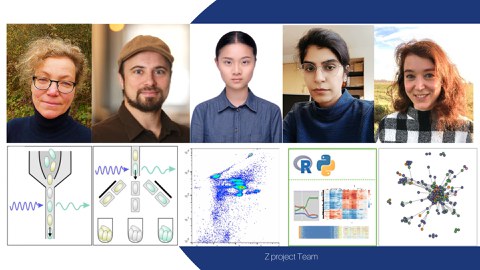Z-Project
- Prof Dr Susann Müller Helmholtz-Zentrum für Umweltforschung (UFZ), Themenbereich Umwelt- und Biotechnologie.
- Prof Dr Christian Müller Helmholtz-Zentrum München (UFZ), Institut für Computational Biology (ICB).
Microorganisms form the largest biomass on earth. Their preferred form of life is the biofilm, a collective lifestyle distinct from that of individual planktonic cells. Collective life forms have advantages that overcome the limitations of solitary life and have emergent functions that ultimately evolve from joint interactions that would not have arisen otherwise. The overarching function that emerges only due to a collective life form cannot be deciphered on an overall population level.
The nature and extent of emergent functions depend on the type, number, and distribution of encompassed heterogeneous cells and their physiological states, i.e., the phenotypes, as well as the interactions between the phenotypes and between these cells and the environment.
In this Z-project, we propose to resolve bacterial collectives and biofilms on a single-cell level with flow cytometry, cell sorting, and multi-omics data science across distinct species. This approach will help quantify the role of individual cells in a bacterial collective as well as their emergent functions.
By partnering with several research groups within this SPP, we will investigate a wide range of bacterial model systems, including B. subtilis, P. aeruginosa, E. coli, Synechocystis, Anabaena, and V. cholerae. We propose to quantify and visualize the phenotypic heterogeneity of bacterial collectives at the single-cell level using multi-parametric flow cytometry. We will use and develop a wide range of fluorescent techniques to characterize different phenotypes.
Using state-of-the-art clustering and gating techniques, we will use these readouts to partition a bacterial collective into subpopulations with distinct physiological characteristics. Sorting these subpopulations by fluorescence-activated cell sorting (FACS) will enable phenotype-specific downstream quantification of functional states using, e.g., RNA-Seq and proteomics. We posit that techniques that specifically address specific functions, such as protein synthesis or DNA synthesis, provide the most direct information about the activity state of individual cells.
The development of these experimental techniques (and their dissemination within the SPP) will be a central pillar of this Z-project. Paralleling these experimental innovations, we will develop data science tools that allow (i) a high-level statistical characterization of cell heterogeneity and phenotypic features from flow cytometric data and (ii) multi-modal and multi-omics data integration of flow cytometric data and downstream molecular data sets.
We believe that the joint development of novel experimental and data science techniques, as proposed here, will ultimately help decipher single-cell specific and emergent collective functions of the bacterial macroscopic structures when observed in a spatiotemporal context.
| Researchers |
|
Dr Sania Arif (Postdoc) Gorkhmaz Abbaszade (Postdoc) |
| Jin Lin (PhD Student) |
| Kathrin Stückrath (Technical Assistant) |
Contact Us
Helmholtz Center for Environmental Research
Email: susann.mueller@ufz.de
Tel: +49 341 235 1318
Helmholtz Center München
Email christian.mueller@stat.uni-muenchen.de
Tel +49 89 2180 3466
Helmholtz Center for Environmental Research
Email: sania.arif@ufz.de
Tel: +49 341 235 1378
Helmholtz Center for Environmental Research
Email: gorkhmaz.abbaszade@ufz.de
Tel: +49 341 235 1378

